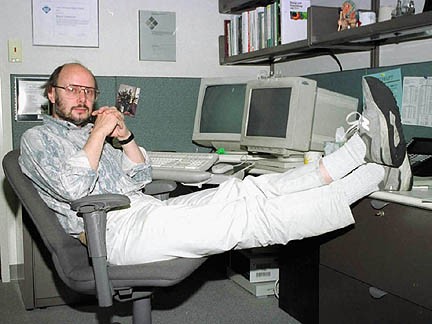So, you’ve decided to learn C++. Maybe it’s a requirement for your studies, or perhaps you’re genuinely fascinated by it.
Often, it’s the former – university assignments, right? 😄
But don’t worry, learning C++ is definitely a worthwhile endeavor.
In fact, I believe learning C++ is highly advantageous. With C++, you can create a wide range of programs.
Think about developing Games, Desktop Applications, Web software, network applications, hacking tools, and even Mobile apps.
In this article, we’ll get acquainted with the C++ language.
Starting from exploring its history and origins, all the way to preparing you for your initial steps in learning C++.
Let’s dive in…
What is C++?
C++ is a programming language created by Bjarne Stroustrup. 1
 Bjarne Stroustrup, creator of the C++ language
Bjarne Stroustrup, creator of the C++ language
Bjarne Stroustrup, creator of the C++ language
As its name suggests, the “++” symbol in C++ signifies an increment of C.
Essentially, C++ is similar to the C language but with more features.
That’s why it’s called C++ (pronounced “C plus plus”).
So, how does it differ from C#?
C# was developed by Microsoft and runs on the .Net virtual machine. In contrast, C++ runs natively, just like C.
Syntax-wise, C++ and C# are quite different. In my opinion, C++ is more similar to C, while C# is closer to Java.
Some even consider C# to be an evolution of C++.
This could be true, as the C# ecosystem – in my view – is more robust compared to C++.
However, rest assured, there’s no such thing as the “best” or “worst” language. Each language has its own strengths and weaknesses.
C# is excellent, but C++ is faster because it runs natively. This native performance is a key reason why C++ remains a powerful choice for performance-critical applications.
The C++ language itself draws significant inspiration from the Simula language.
Why is that the case?
Let’s explore its history…
The History of C++
In 1979, Bjarne Stroustrup, a computer scientist from Denmark, began developing the C++ programming language.
His initial motivation stemmed from his experiences during his Ph.D. thesis work.
During that time, while working on his thesis…
He discovered that the features of the Simula language were incredibly helpful for building large-scale applications.
However, Simula was very slow.
The next part of the story began when he worked at AT&T Bell Labs.
He encountered a problem while analyzing the Unix kernel, particularly in the context of distributed computing.
It was then that he recalled his experience working on his thesis.
Ultimately, he decided to create a new language by extending C and incorporating features similar to Simula. This blend of efficiency and powerful features was the initial spark for C++.
Besides Simula, the design of C++ was also influenced by languages like ALGOL 68, Ada, CLU, and ML.
In 1982, Bjarne’s new language was named C++, and several features were added, including classes, virtual functions, operator overloading, references, constants, and more. These additions significantly expanded the capabilities of C++ beyond its C roots.
In 1985, The C++ Programming Language book was published and became the primary reference for the C++ language at the time. This book played a crucial role in popularizing and standardizing C++.
The C++ Programming Language Book
In 1989, C++ version 2.0 was released, followed by the publication of The C++ Programming Language Second Edition. This version introduced features like abstract classes and protected members, further enhancing the language’s object-oriented capabilities.
In 1998, C++ achieved a language standard known as C++98. This standardization was a major milestone, ensuring consistency and portability across different C++ compilers and implementations.
C++ Language Versions
C++ language versions are determined by the standardization they follow. For example, C++98 refers to the version of C++ that adheres to the 1998 standard.
The standardization of C++ is conducted by ISO (International Organization for Standardization).
Why is standardization necessary?
It’s crucial to prevent C++ from being implemented arbitrarily. Many entities create C++ compilers.
The purpose of standardization is to ensure uniformity across all these compilers.
Imagine if C++ compilers from IBM and the GNU community had different implementations.
It would become very complicated for developers. We’d have to learn C++ IBM-style and C++ GNU-style.
Therefore, standardization is essential for a consistent and portable programming experience.
Currently, C++ has several standards:
| Year | C++ Standard Name | Common Name |
|---|---|---|
| 1998 | ISO/IEC 14882:1998[23] | C++98 |
| 2003 | ISO/IEC 14882:2003[24] | C++03 |
| 2011 | ISO/IEC 14882:2011[25] | C++11, C++0x |
| 2014 | ISO/IEC 14882:2014[26] | C++14, C++1y |
| 2017 | ISO/IEC 14882:2017[9] | C++17, C++1z |
| 2020 | In development | C++20,[17] C++2a |
Each new version introduces new features and improvements, which are then formalized through standardization.
So, which version should you use?
If you’re just starting to learn, you don’t need to worry too much about this initially.
Because the basics remain the same across versions.
The differences lie in the features. Some functions are added, and some might be removed.
For fundamental concepts like variables, if statements, loops, functions, and so on, they are consistent across all versions. For beginners focusing on learning C++ coding easily, the core concepts are the most important starting point.
Examples of Applications Built with C++
There are countless applications built using C++. I’ll mention just a few that I’m familiar with:
First, there’s Inkscape, which is a vector graphics editor similar to CorelDraw and Adobe Illustrator. Inkscape is built with C++ and GTK+ 3.
Second, we have Krita, an application for digital painting and illustration. Krita is also created with C++ and Qt 5.
Besides these two impressive applications, many more are built using C++:
- Winamp Media Player;
- MySQL Server;
- Mozilla Firefox;
- Thunderbird;
- Google Chrome;
- Microsoft Office Suite;
- Adobe Photoshop;
- Adobe Illustrator;
- Java Virtual Machine (JVM);
- KDE Desktop Environment;
- Apple macOS UI (Aqua);
- and many, many more…
C++ is truly amazing, isn’t it? 😍 Its versatility and performance make it a cornerstone in software development.
What’s Next?
We’ve now become acquainted with the C++ language and learned about its history and origins.
Essentially, C++ is an enhanced version of the C language, capable of creating a wide variety of programs and applications.
Next, we’ll start learning C++ programming practically, but before that… let’s prepare our tools.
Please proceed to:
📖 For a list of other C++ tutorials, see the C++ Tutorial List
Happy learning!

